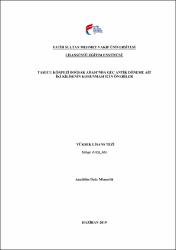Taşucu Körfezi Boğsak Adası’nda Geç Antik Döneme Ait İki Kilisenin Korunması İçin Öneriler
Citation
ARSLAN, Nihan, Taşucu Körfezi Boğsak Adası’nda Geç Antik Döneme Ait İki Kilisenin Korunması İçin Öneriler, Fatih Sultan Mehmet Vakıf Üniversitesi Lisansüstü Eğitim Enstitüsü Mimarlık Anabilim Dalı, Yayımlanmamış Yüksek Lisans Tezi, 2019.Abstract
Bu çalışma, antik dönemin Kilikya-Isaurya Bölgesi, günümüzde Mersin İli, Silifke İlçesi, Taşucu Körfezi Boğsak Adası’nda bulunan ve Geç Antik döneme tarihlendirilen yapı grubunun detaylı rölövesinin çizilmesi, restitüsyon önerilerinin geliştirilmesi ve koruma projesinin hazırlanmasını amaçlamaktadır.
Boğsak Adası, çok sayıda yapı kalıntısının bulunduğu bir Geç Antik dönem yerleşimi olmasıyla ön plana çıkar. Yapı grubu Kilise 1 ve Kilise 5 olmak üzere iki kilise, iki yer üstü (Büyük Sarnıç ve Güney Sarnıç) ve bir yer altı sarnıcı (L Sarnıç), bir tonozlu mezar odası, iki platform, kuzeyindeki kavisli çevre duvarı ve Kilise 1’in etrafındaki toplam sekiz adet ek mekândan oluşmaktadır. 20. yüzyıldan itibaren adanın az sayıda araştırmacı tarafından ziyaret edildiği bu kişilerin yayınlarından dolayı bilinmektedir. Bu yayınlarda özellikle bu yapı grubundaki en iyi korunan yapı olan Kilise 5 yer almaktadır. Ancak şimdiye kadar Kilise 5 de dahil yapı grubunun detaylı rölövesi çizilmemiş, restitüsyon önerileri geliştirilmemiş ve koruma projesi hazırlanmamıştır. Bu çalışmada Boğsak Adası’ndaki söz konusu bu yapı grubu ayrıntılı biçimde çizimlerle belgelenmiştir. Bu çizimlerden elde edilen verilerle, yapı grubundaki kiliselerin Kilikya kiliseleri içindeki yeri belirlenmeye çalışılmış ve koruma önerileri geliştirilmiştir.
Bu çalışmanın konusu yapı grubundaki iki kilisedir. Kilise 1, büyük olasılıkla, galerili ve güneyinde yarı açık, doğusunda ise çift apsisli kapalı koridoru olan bazilikal planlı bir yapıdır. Boyut olarak adadaki en büyük kilise olsa da Kilikya Bölgesi’ndeki kiliselerle karşılaştırıldığında bölgedeki orta boyutlu bazilikalardan biridir. Kuzeydoğusundaki Kilise 5 ise yaklaşık kare içinde haç planlı, doğusunda dışarı taşan yarım daire planlı bir apsisi olan kubbeli bir şapeldir. İki yapının arasında narteks olarak tanımlanabilecek bir geçiş mekânı yer alır. Rölöve ve restorasyonda kiliselerin çevresindeki sivil yapılar ve sarnıçlar da detaylı şekilde çizilmiştir. Restitüsyonda yapı grubundaki kiliseler, Kilikya ve Pamfilya başta olmak üzere yakın bölgelerdeki benzer özelliklere sahip yapılarla karşılaştırılmış, sivil yapılar ve sarnıçlar içinse yalnızca kütle önerisinde bulunulmuştur.
Kilise 1 ve Kilise 5’ten oluşan bu yapı grubu, Kilikya Bölgesi içinde özgün detayları oldukça iyi korunmuş bir anıt grubudur. Her iki yapıdan ve analoji çalışmasından elde edilen veriler, bu kiliselerin özel niteliklere sahip olduğunu düşündürmektedir. Plan şemaları ve yapıların birbirleriyle olan ilişkisi göz önüne alındığında yapı grubu Kilikya Bölgesi’nde Geç Antik çağa tarihlendirilen kiliseler içerisinde önemli bir mevki kazanmaktadır. Bu nedenle alanda sürdürülecek araştırmalarla birlikte, yapıların özgün karakterine ilişkin daha kesin verilere ulaşılmalı ve koruma önerileri doğrultusunda yapı grubunun mevcut durumunun devamlılığı sağlanmalıdır. The aim of this study is to prepare the measured drawings in detail, to develop restitution proposals and to prepare conservation project for a group of structures dated to the Late Antiquity period in Cilicia-Isauria, today in Mersin Province, Silifke District, Boğsak Island at Taşucu Gulf.
Boğsak Island stands out as a Late Antique settlement with many remains of buildings. The building group includes two churches, Church 1 and Church 5, two overground cisterns (The Great Cistern and The South Cistern) and one subterranean cistern (L Cistern), one vaulted funerary chamber, two platforms, curvilinear wall at the north of the buildings and eight additional units around of the Church 1. The island visited by a small number of researchers is known from the publications of these people since 20. century. In these publications, the researchers especially reported about Church 5, which is the best preserved structure in this building group. However, no detailed survey of the building group including Church 5 has been drawn, restitution proposals have not been developed and no conservation project has been prepared until this time. In this study, above-mentioned building group in Boğsak Island is documented in detail with drawings. With the data obtained from these drawings, the churches of this building group was tried to be placed among Cilicia Churches in regarding typology, plan types, materials…etc. and conservation proposals were developed.
This study mainly focuses on the two churches of the building group. Church 1 has presumably a basilical plan with a gallery and an indoor corridor with double apses to the east and a portico to the south. Although it is the largest church on the island, in comparison with the churches in Cilicia in size, it can be categorized as a middle size done. Church 5 situated to the northeast of the Church 1, has a cross in square plan with a dome and a semi-circular apse projecting to the east. Between the two structures, there is a transition space which can be defined as narthex. In the survey and restoration proposal, civil structures and cisterns around the churches were also drawn in detail. In the restitution, the churches in the building group were compared with buildings with similar features in the nearby regions, especially in Cilicia and Pamphylia, but the civil structured were not handled into detail.
Church 1 and Church 5, is a well-preserved monument group with original characteristic details in Cilicia. Data from both structures and analogy study suggest that these churches have special features. Considering the plan schemes and the relations of the structures with each other, the building group has an important place amoung the churches of dated to the Late Antiquity in Cilicia. Therefore, with the
future researches which will be carried the field, more precise data about the original character of the buildings can be reached and the current state of conservation of the building group should be maintained according the conservation proposals.



















